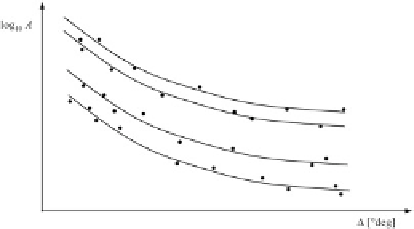Geology Reference
In-Depth Information
earthquake size through the offset of log
10
A
from
a reference value:
10.4
Earthquake Magnitude
The size of earthquakes is usually measured
through their
magnitude
. There are several
empirical magnitude scales, which are based
on simple measurements of the largest seismic
wave amplitude as recorded on seismograms.
In the 1930s, Charles Richter proposed what
is now known as the
local magnitude
,
M
L
(Richter
1935
). While cataloging data from the
southern California seismic network, Richter
observed that plots of the logarithm of the
largest amplitude,
A
, recorded on a standard
instrument, the
Wood
-
Anderson seismograph
,
versus epicentral distances exhibited the same
decay rate (Fig.
10.18
).
We recall that the amplitude of seismic
waves decays as a consequence of geometrical
spreading and attenuation. Therefore, the
displacement recorded on seismograms may
reflect the earthquake size only after a correction
that accounts for the epicentral distance.
Furthermore, the displacement results to be
proportional to the moment
rate
(see Eqs.
10.50
and
10.51
), not to the scalar moment (which is
the correct quantity describing earthquake sizes).
However, the necessity to determine promptly
earthquake magnitudes through simple routine
measurements has led to the widespread usage of
scales based on waveform amplitudes. Richter,
in particular, observed that the
distance
between
the decay curves of two different earthquakes
appeared to be approximately independent from
the epicentral distance. Therefore, it was possible
to define a distance-independent measure of the
M
L
D
log
10
A./
log
10
A
0
./ (10.59)
Richter built his scale using a reference epi-
central distance
X
D
100 km and a reference am-
plitude
A
0
D
10
3
m. Using these values, (
10.59
)
can be rewritten as follows:
M
L
D
log
10
A./
C
2:76log
10
2:48
(10.60)
The largest amplitude on Wood-Anderson tor-
sion seismometers is generally associated with
the
S
wave arrival on horizontal sensors. Earth-
quakes with
M
L
2.5 are not generally felt by
people, so that they are called
microearthquakes
.
Since dominant period of the Wood-Anderson in-
trument (0.8 s) is similar to that of most buildings,
the Richter (or local) scale is especially useful
in engineering seismology. This scale is also
important because all the more recent magnitude
scales have been tied to it. A much more useful
scale in plate tectonics is the
moment magnitude
scale proposed by Kanamori (
1977
), which is
defined as follows:
2
3
log
10
M
0
6:03
M
w
D
(10.61)
where
M
0
is the scalar moment measured in
N m. This expression shows that the moment
magnitude scale provides a simple way to write
the large numbers usually associated with the
scalar moment. We also note that a unit increase
in
M
w
does not coincide with a tenfold increase in
earthquake size. Rather, if
M
0
changes from 10
n
to 10
n
C 1
,then
M
w
will increase by 2/3.
10.5 Gutenberg-Richter Law
Tens of years of seismological observation have
shown that there exists a precise statistical rela-
tionship between the magnitude of earthquakes
and their recurrence time. Gutenberg and Richter
(
1956
) were among the first seismologists to
Fig. 10.18
Amplitude decay curves for four earthquakes




